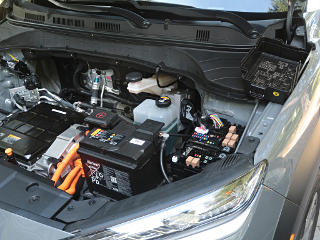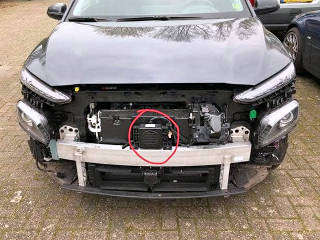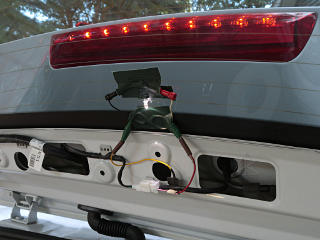
|
A friend and Arisia colleague was kind enough to give me that one-way ride
out to the dealership, and not only was the delivery process fairly quick
and painless, they even had the donut spare I ordered ready for me.
The "EV" plates were on the car and all the paperwork in good order.
I probably made life easier for them on several points --
they honored my request for absolutely no interior treatment or sidewall
"tire shine", and did not try to sign me up for BlueLink.
As one of the few customers that actually reads owner manuals I didn't
have to spend very long with the "delivery specialist" as I probably knew
more about the car than he did by then, and I was soon on my way off the
lot and tooling happily along the highway.
Well, for all of about five minutes. Now that it was MINE, it was time to dig in and start playing with stuff. I pulled off into a shady spot at the back of a CVS parking lot a little way down the road, and spent the next while crawling all over the car. |

|
Like many newer hybrid and electric vehicles, the Kona comes with a noisemaker that comes on when the car is ready to move at low speeds. In Hyundai-ese it's called VESS, or "virtual engine sound system", but what it emits is less "engine" and more of a musical Jetsons-rocket-car kind of sliding chord. It's simply a speaker mounted under the front end, with a sampled audio track that gets commanded to vary in pitch to follow the car's speed, fading out above a certain point when tire noise becomes louder. It's a federally mandated item for electric-drive vehicles from model years 2020 and up, a year or so after the equivalent EU directive emerged, the theory being to alert blind or inattentive pedestrians that the car is there and moving. Regardless of the stats presented in the NHTSA rulemaking, it is arguably yet another attempt to solve stupidity with technology. The studies describe a small but sufficient percentage of effectiveness that our nanny state concludes that it's a good idea. |
|
Except that there are already plenty of vehicles on the road today that
move silently when they start off, with no mandate to retrofit *them* with
some kind of noisemaker.
The mandate does not cover larger, heavier vehicles at all -- many of
which also are or will be electric and move silently.
As well, regular ICE cars are effectively silent at low speeds in the
hubbub of a typical urban environment.
Most owners
express annoyance
at such automated palliatives, and there were
inevitably questions on several forums to the effect of "that was amusing
for all of two days, now how do I disable this asinine thing?"
In the European market, the answer is easy: there is a *button* provided
on the dash to disable the VESS, even if it defaults to enabled when the
car powers up.
Similar to the "EV button" in the Japanese-market second generation Prius,
automakers surmised that Americans are too stupid to make intelligent
decisions about such features and left the switch out, simply forcing
what they consider the marginally "safer" option.
The easiest answer on the US version is to fish a hand under the front trim and disconnect the speaker box entirely. The connector is sort of hidden behind the radiator when viewed from the under-hood area, in the area pointed at by the blue arrow, but can usually be unclipped by squeezing the lock tab and pulling by feel. No errors/warnings are generated, and the car is refreshingly silent thereafter. You can debate the merits of arguments on both sides all day, and indeed some people have spent way too much time on it, not to mention the design acoustics of appropriate soundscapes. What I've personally found far more effective near people who aren't necessarily paying attention, is to yell "car moving!" out the window before actually moving. [If they're into theatre work, they might even answer, "thank you moving!"] It's the same idea as commercial drivers who give a couple of quick toots of the horn before rolling out -- a consideration for safety of nearby people, but entirely under the driver's control and mercifully brief. | |

|
Here's the VESS box in context, in a shot swiped from a forum post where the owner had removed the entire front end plastic of the car. It is actually a CANbus node, with its volume and pitch of playback commanded by vehicle-speed data from other control units on the network. Another owner figured out the relevant packets and reproduced the car's operation of it, and documented his results in the same thread. |
|
I knew the tires at door-placard pressure were far softer than I wanted and
even though I had the donut spare, I pulled out the little compressor from
the "mobility kit" and gave it a try.
It is *ear-shatteringly* loud, and like all such toys, depressingly
slow at actually pushing air into a tire.
I put up with the racket long enough to check all the tires and push
them up to about 40 psi.
Most owners would probably never even crack the thing out of its plastic
wrapper; in the event of a flat they'd just hop on the phone or Bluelink
to "roadside assistance" and helplessly wait for someone to show up.
That was enough dorking around for the moment; I got back on the road and headed toward home. Almost immediately beset with aggressive tailgaters and for once unable to do anything about it, I knew that building a Yuppie Button for this would be a high priority, as would finding and disabling its cellular data connectivity. BlueLink signup or not, I assumed that the onboard telematics were still likely to be "phoning home" in some way and reporting GPS locations, and that wasn't unacceptable. Plenty more work to do, literally. On arriving home, I got out my nice quiet hand pump and pushed the 51 sidewall-PSI Nexen tires right up to 60 or so, following the beneficial wisdom that the hypermiler community has espoused for years. A bit more labor-intensive on these larger tires than the Prius, but entirely doable. What's hilarious is that the TPMS pressure display in the car reads "51" all around when this is done, instead of simply reading the pressure as is. Maybe it's a limitation of the installed sensors. The ride felt nicely firmer afterward, giving that "rolling like a bicycle" feel, and my miles-per-kilowatthour average definitely went up. There's apparently no way to recalibrate the "low tire" alarm setpoint; it's fixed at 30 PSI or something. At least there doesn't seem to be a high setpoint, as the system did not issue any whining about "overinflation". |

|
A question had come up on one of the forums about strong regenerative deceleration, whether use thereof would light the brake lights even if the physical brake pedal wasn't used in the process. The official answer in the relevant thread was that yes, above a certain decelerative rate the brake lights were *supposed* to come on but most folks weren't sure of the reality. To answer this question for myself, I put in a quick-n-dirty brake-light telltale by backpinning the third-eye connector into an LED taped to the back window and pointing forward, where I could see it in the rear-view. Without it there was no way to tell if the brake lights were on, and this was far simpler than someone else's hack of mounting a GoPro on the back of the car somehow. |
| While this was enough to get some generic early answers, I found that it is generally useful to know when the brake-pedal switch is asserted, and would later turn this into a permanent feature at the instrument cluster. | |
_H* 190927